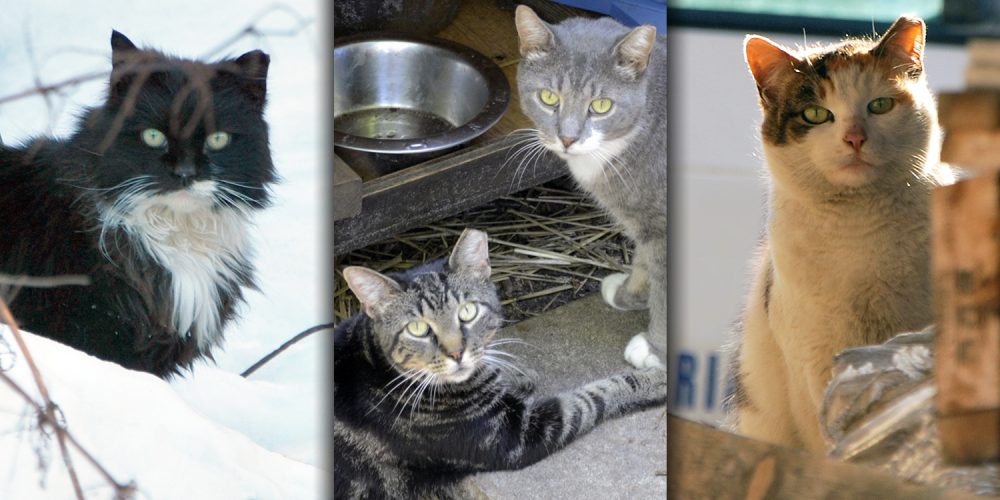
For more than 10,000 years, cats have lived outdoors, “as citizens of the natural landscape,” so eloquently stated on Alley Cat Allies’ website. But in the mid-20th century, thanks to the invention of kitty litter, we started to welcome cats indoors with us as companions in our homes. Not long after, thousands upon thousands of cats were brought into animal shelters, where most of them were killed because they weren’t socialized to people and couldn’t be adopted out as pets.
Sadly, untold thousands of healthy cats lost their lives needlessly in shelters and in the field because of catch-and-kill policies. These policies were based on the false assumptions that miss out on the truth that it’s perfectly normal for cats to live outdoors.
With the founding in 1990 of Alley Cat Allies, the fledgling organization that would become the global leader in the movement to protect cats and kittens, perceptions began to change. Alley Cat Allies and other advocacy groups have helped more people understand that every cat has intrinsic value, whether living inside or outside. They deserve to live out their lives to the fullest, without the threat of being rounded up and killed.
Trap-Neuter-Return (TNR) began to gain popularity in the U.S. just as it had already done in Europe. Now a mainstream practice, TNR is the only humane and effective approach to address community cat populations. With TNR, cats living outdoors are humanely trapped, spayed or neutered, vaccinated, surgically and painlessly ear-tipped on the left ear for identification, and returned to their territory. Caregivers provide them with food, shelter, and medical care. Whenever possible, kittens and friendly cats are taken in for adoption.
Alley Cat Allies was instrumental in gaining wider acceptance for TNR by connecting like-minded TNR enthusiasts in communities across the country. Once a few key community players were connected with help from Alley Cat Allies, TNR took off.
While TNR had gained significant traction in New York City by 2000, thousands of cats were still being euthanized. When the Mayor’s Alliance was founded in 2003 to transform New York City into a no-kill community, we recognized the need to dramatically intensify efforts to reduce the number of feral community cats entering and being killed at the city’s shelters.
So the Mayor’s Alliance created the NYC Feral Cat Council in 2004 to provide visibility for the network of people and groups doing TNR in New York City. The following year, we stepped up efforts to expand TNR by creating the NYC Feral Cat Initiative (NYCFCI). The NYCFCI provided a more robust approach to addressing the community cat issue by offering concrete services and resources, including a broad array of training opportunities, to individuals and organizations caring for community cats and performing TNR. In 2019, we transferred the program to Bideawee.
In New York City and across the country, society’s perceptions about community cats and the value of TNR began to change. And animal welfare policies evolved. More and more national and local organizations began to embrace TNR as the preferred method of managing community cats.
The Humane Society of the United States’ (HSUS) position on outdoor cats, as it appears on its website, states: “…we support Trap-Neuter-Return (TNR) and similar sterilization programs, legislation that allows for and supports non-lethal population control, and coalition-based approaches that involve community leaders, citizens, and stakeholders to implement effective community cat management programs. Programs that attempt to use lethal control to eliminate cat populations are inhumane, ineffective, and wasteful of scarce resources.”
The American Society for the Prevention of Cruelty to Animals (ASPCA) takes a similar position on community cats and community cat programs, stating on its website: “The ASPCA supports humane, lawful, and effective strategies for humanely managing community cat populations, including programs involving trap-neuter-return-monitor (TNRM), return to field (RTF) or, as a last resort, community cat relocation (CCR). Such community cat programs not only provide life-saving options for cats who might otherwise be euthanized when admitted to a shelter but also can stabilize, and even reduce over time, the population of community cat colonies (Levy and Crawford, 2004; Robertson, 2008).”
And the National Animal Care & Control Association’s (NACA) position on the intake of free-roaming cats states “…at every opportunity, officers should [will] work to educate the public regarding humane and responsible co-existence and care of pet and community cats, to include education on the benefits and resources for spay/neuter and vaccination; responsible feeding and management practices for those choosing to care for community cats; and effective methods to humanely deter and exclude animals from homes, structures and targeted areas. It is the position of NACA that indiscriminate pick up or admission of healthy, free-roaming cats, regardless of temperament, for any purpose other than TNR/SNR, fails to serve commonly held goals of community animal management and protection programs and, as such, is a misuse of time and public funds and should be avoided.”
As cities and towns across the country tackle the challenges presented by their community cat populations, many are embracing the wisdom of implementing policies that support TNR. Nearly a decade ago, New York City lead by example when then Mayor Michael Bloomberg signed Local Law 59, which endorses TNR as the approved and recommended method for controlling and decreasing the numbers of free-roaming community and feral cats in all areas of New York City, public and private. This landmark legislation recognized TNR as the preferred method of managing feral cat populations. The Mayor’s Alliance was a strong proponent of, and helped to craft, this important legislation.
The Mayor’s Alliance continues to promote TNR because TNR works. “Scientific studies and communities with TNR programs are proof that TNR stabilizes populations of community cats,“ says Becky Robinson, President and Founder of Alley Cat Allies.
To learn more about TNR and community cats, and how you can become a part of the growing movement to help improve their quality of life, visit Alley Cat Allies and Bideawee’s Feral Cat Initiative.


